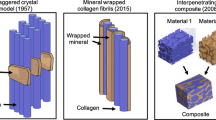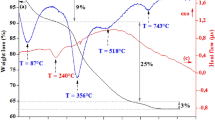Abstract
A method is described employing 95% hydrazine which completely deproteinates and slightly dehydrates bone under nearly anhydrous conditions with only moderate heating. This method induced only minor chemical changes and no alterations in structural properties of the mineral phase. Physicochemical data are presented demonstrating that although rat bone crystals more closely resemble synthetic controls made in carbonate-rather than hydroxide-rich media, rat bone apatite cannot be interpreted in terms of known or postulated crystal models in any meaningful fashion. CO 2−3 infrared band assignments made from spectra of whole bone are shown to be in error due to the presence of protein absorption bands. Absorotion of HPO 2−4 was observed in infrared spectra of young rat bone mineral. Detailed X-ray diffraction comparisons of deproteinated rat bone before and after hydrolysis clearly demonstrated the presence of amorphous calcium phosphate. Electron microscopy indicated that very small apatite crystals were present in rat bone which might also contribute to the overall mineral pool amorphous to X-ray diffraction. Electron microscopy also showed domains in rat bone mineral where plate-like apatite crystals maintained a netc-axis orientation despite the removal of their fibrous matrix.
Résumé
Une méthode, utilisant 95% d'hydrazine, permet de déprotéiniser et de déshydrater légèrement l'os dans des conditions presqu'anhydres, avec une élévation de température modérée. Cette méthode ne provoque que des modifications chimiques mineures, sans altération des propriétés structurales de la phase minérale. Les résultats physico-chimiques démontrent que bien que les cristaux d'os de rat sont viosins de cristaux synthétiques témoins constitués dans des milieux, riches en carbonate plutôt qu'en hydroxyde, l'apatite osseux de rat ne parait pas analogue à des modèles cristallins connus ou imaginés. Des déterminations de bande infra-rouge CO 2−3 , réalisées à partir de spectre d'os total, semblent faussées par la présence de bandes d'absorption protéique. L'absorption d'HPO 2−4 est étudiée à l'aide de spectres infra-rouges de minéral osseux de jeunes rats. Des comparaisons détaillées en diffraction par raysons X d'os déprotéinisé de rats, avant et après hydrolyse, démontrent nettement la présence de phosphate de calcium amorphe. La microscopie électronique indique que de petits cristaux d'apatite dans l'os de rat sont susceptibles de contribuer au pool minéral amorphe en diffraction en rayons X. La microscopie électronique montre des plages de minéral osseux de rat où des cristaux d'apatite en forme de plaque, présentent une maille cristalline avec axe C malgré l'élimination de leur matrice fibreuse.
Zusammenfassung
Es wird eine Methode beschrieben, wobei durch Anwendung von 95% Hydrazin ohne Wasserzugabe und mit nur geringem Erhitzen dem Knochen das gesamte Protein und ein kleiner Teil des Wassers entzogen wird. Diese Methode führte nur zu geringen chemischen Veränderungen und veränderte die strukturellen Eigenschaften der Mineralphase in keiner Weise. Physikochemische Daten wurden erbracht, welche zeigen, daß — obwohl die Kristalle von Rattenknochen den synthetischen Kontrollen (in Karbonat- und nicht hydroxydreichen Medien hergestellt) eher gleichen — Apatit aus Rattenknochen nicht auf sinnvolle Weise mittels bekannten oder postulierten Kristallmodellen interpretiert werden kann. CO 2−3 -Infrarotbandenzuteilungen, welche von Spektren aus dem Gesamtknochen gemacht wurden, geben wegen der Anwesenheit von Proteinabsorptionsbändern falsche Resultate. Die Absorption von HPO 2−4 wurde in den Infrarotspektren von Knochenmineral aus jungen Ratten beobachtet. Ein Vergleich der detaillierten Röntgendiffraktion von deproteinisiertem Rattenknochen vor und nach der Hydrolyse wies deutlich auf die Anwesenheit von amorphem Calciumphosphat hin. Die Elektronenmikroskopie zeigte kleine Apatitkristalle im Rattenknochen, welche zum Gesamtmineralpool beitragen könnten, der bei der Röntgendiffraktion amorph ist. Die Elektronenmikroskopie zeigte auch Gebiete im Rattenknochenmineral, wo plättchenartige Apatitkristalle eine deutlichec-Achsenorientierung beibehielten, obwohl ihre fibröse Matrix entfernt worden war.
Similar content being viewed by others
References
Akabori, S., Ohno, K., Navita, K.: On the hydrolysis of proteins and peptides: a method for the characterization of carboxy-terminal amino acids in proteins. Bull. Chem. Soc. Japan25, 214–218 (1952).
Alexander, L. E.: X-ray diffraction methods in polymer science, p. 137–197. New York: John Wiley and Sons, Interscience 1969.
Armstrong, W. D., Singer, L.: Composition and constitution of the mineral phase of bone. Clin. Orthop.38, 179–190 (1967).
Baxter, J. D., Biltz, R. M., Pellegrino, E. D.: The physical state of bone carbonate: a comparative infrared study in several mineralized tissues. Yale J. Biol. Med.38, 456–470 (1966).
Beer, M., Sutherland, G. B. B. M., Tanner, K. N., Wood, D. L.: Infrared spectra and structure of proteins. Proc. Roy. Soc. (London)249A, 147–172 (1959).
Bienenstock, A., Posner, A. S.: Calculation of the x-ray intensities from arrays of small crystallites of hydroxyapatite. Arch. Biochem. Biophys.124, 604–607 (1968).
Doty, S. B., Mathews, R. S.: Electron microscopic and histochemical investigation of osteogenesis imperfecta tarda. Clin. Orthop.80, 191–201 (1971).
Eanes, E. D., Gillessen, I. H., Posner, A. S.: Intermediate states in the precipitation of hydroxyapatite. Nature (Lond.)208, 365–367 (1965).
Eanes, E. D., Posner, A. S.: Intermediate phases in the basic solution preparation of alkaline earth phosphates. Calcif. Tiss. Res.2, 38–48 (1968).
Eastoe, J. E.: The chemical composition of bone. In: Biochemists' handbook (C. Long, ed.), p. 715–720. Princeton: Van Nostrand 1961.
Elliott, J. C.: The interpretation of the infrared absorption spectra of some carbonate-containing apatites. In: Tooth enamel. Its composition, properties and fundamental structure (M. V. Stack and R. W. Fearnhead, eds.), p. 20–22 and 50–58. Bristol: John Wright and Sons, LTD. 1965.
Emerson, W. H., Fischer, E. E.: The infra-red absorption spectra of carbonate in calcified tissues. Arch. oral Biol.7, 671–683 (1962).
Fowler, B. O.: Infrared spectra of apatites. In: Internat. Symposium on structural properties of hydroxyapatite and related compounds (R. A. Young and W. E. Brown, eds.), chapter 7. New York: Gordon and Breach. In press, 1968.
Fowler, B. O., Moreno, E. C., Brown, W. E.: Infra-red spectra of hydroxyapatite, octacalcium phosphate and pyrolysed octacalcium phosphate. Arch. oral Biol.11, 477–492 (1966).
Furedi, H., Walton, A. G.: Transmission and attenuated total reflection (ATR) infrared spectra of bone and collagen. Appl. Spectroscopy22, 23–26 (1968).
Gee, A., Deitz, V. R.: Determination of phosphate by differential spectrophotometry. Analyt. Chem.25, 1320–1324 (1953).
Gee, A., Deitz, V. R.: Pyrophosphate formation upon ignition of precipitated basic calcium phosphates. J. Amer. chem. Soc.77, 2961–2965 (1955).
Glimcher, M. J., Krane, S. M.: The organization and structure of bone and the mechanism of calcification. In: Treatise on collagen, vol. 2B (B. S. Gould, ed.), p. 68–251. New York: Academic Press 1968.
Greenfield, D. J., Eanes, E. D.: Formation chemistry of amorphous calcium phosphates prepared from carbonate containing solutions. Calcif. Tiss. Res.9, 152–162 (1972).
Harper, R. A., Posner, A. S.: Measurement of non-crystalline calcium phosphate in bone mineral. Proc. Soc. exp. Biol. (N. Y.)122, 137–142 (1966).
Höhling, H. J., Kreilos, R., Neubauer, G., Boyde, A.: Electron microscopy and electron microscopical measurements of collagen mineralization in hard tissues. Z. Zellforsch.122, 36–52 (1971).
Huc, A., Sanejuoand, J.: Étude du spectre infrarouge du collagène acidosoluble. Biochim. biophys. Acta (Amst.)154, 408–410 (1968).
Itoh, K., Shimanouchi, T., Oya, M.: Far infrared spectra of poly (−α-amino acids) with basic alkyl group side chains. Biopolymers7, 649–658 (1969).
LeGeros, R. Z., Trautz, O. R., Klein, E., LeGeros, J. P.: Two types of carbonate substitution in the apatite structure, Experientia (Basel)24, 5–7 (1969).
Lowry, O. H., Rosebrough, N. J., Farr, A. L., Randall, R. J.: Protein measurement with the Folin phenol reagent. J. biol. Chem.193, 265–275 (1951).
Miller, E. J., Martin, G. R., Piez, K., Powers, M. J.: Characterization of chick bone collagen and compositional changes associated with maturation. J. biol. Chem.242, 5481–5489 (1967).
Miyazawa, T.: Infrared spectra and helical conformation. In: Poly-α-amino acids, vol 1 (G. Fasman, ed.), p. 69–103. New York: Marcel Dekker 1967.
Murphy, A. P., McNeil, G. L., Neal, K. J.: Ultramicrotome for hard tissue. Rev. Sci. Instr.38, 921–924 (1967).
Niu, C. I., Fraenkel-Conrat, H.: Determination of C-terminal amino acids and peptides by hydrazinolysis. J. Amer. chem. Soc.77, 5882–5885 (1955).
Nylen, M. U., Eanes, E. D., Termine, J. D.: Molecular and ultrastructural studies of noncrystalline calcium phosphates. Calcif. Tiss. Res.9, 95–108 (1972).
Ohno, K.: On the structure of lysozyme. III. On the carboxyl-terminal peptide. J. Biochem. (Japan)42, 615–625 (1955).
Orr, S. F. D.: Infra-red spectroscopic studies of some polysaccharides. Biochim. biophys. Acta (Amst.)14, 173–181 (1954).
Peckham, S., Losee, F. L., Ettleman, I.: Ethylenediamine versus potassium hydroxideglycol in the removal of organic matter from dentine. J. dent. Res.35, 947–949 (1956).
Quinaux, N., Richelle, L. J.: X-ray diffraction and infrared analysis of bone specific gravity fractions in the growing rat. Israel J. med. Sci.3, 677–690 (1967).
Ramachandran, G. N.: Structure of collagen at the molecular level. In: Treatise on collagen, vol.1 (G. N. Ramachandran, ed.), p. 185–206. New York: Academic Press 1967.
Scott, D. B.: The crystalline component of dental enamel. In: Proceedings, fourth international congress of electron microscopy, vol. 2, p. 348–351. Berlin-Heidelberg-New York: Springer 1960.
Spurr, A. R.: A low-viscisity epoxy resin medium for electron microscopy. J. Ultrastruct. Res.26, 31–43 (1969).
Stutman, J. M., Termine, J. D., Posner, A. S.: Vibrational spectra and structure of the phosphate ion in some calcium phosphates. Trans. N.Y. Acad. Sci.27, 669–675 (1965).
Susi, H.: Infrared spectra of biological macromolecules and related systems. In: Structure and stability of biological macromolecules (S. N. Timasheff and G. D. Fasman, eds.), p. 575–663. New York: Marcel Dekker 1969.
Swedlow, D. B., Harper, R. A., Katz, J. L.: Evaluation of a new preparative technique for bone examination in the SEM. In: Scanning electron microscopy 1972 (part III). Proceedings, workshop on biological scanning electron microscopy, p. 335–342. Chicago: IIT Research Institute 1972.
Termine, J. D., Eanes, E. D.: Comparative chemistry of amorphous and apatitic calcium phosphate preparations. Calcif. Tiss. Res.10, 171–197 (1972).
Termine, J. D., Eanes, E. D., Ein, D., Glenner, G. G.: Infrared spectroscopy of human amyloid fibrils and immunoglobulin proteins. Biopolymers11, 1103–1113 (1972).
Termine, J. D., Posner, A. S.: Infrared analysis of rat bone: age dependency of amorphous and crystalline mineral fractions. Science153, 1523–1525 (1966).
Termine, J. D., Posner, A. S.: Amorphous/crystalline interrelationships in bone mineral. Calcif. Tiss. Res.1, 8–23 (1967).
Trombe, J. C., Bonel, G., Montel, G.: Sur les apatites carbonatées préparées à haute tempèrature. Bull. Soc. Chim. Fr. (no special) 2e trimestre, 1708–1712 (1968).
Williams, J. B., Irvine, J. W.: Preparation of the inorganic matrix of bone. Science119, 771–772 (1954).
Author information
Authors and Affiliations
Rights and permissions
About this article
Cite this article
Termine, J.D., Eanes, E.D., Greenfield, D.J. et al. Hydrazine-deproteinated bone mineral. Calc. Tis Res. 12, 73–90 (1973). https://doi.org/10.1007/BF02013723
Received:
Accepted:
Issue Date:
DOI: https://doi.org/10.1007/BF02013723




